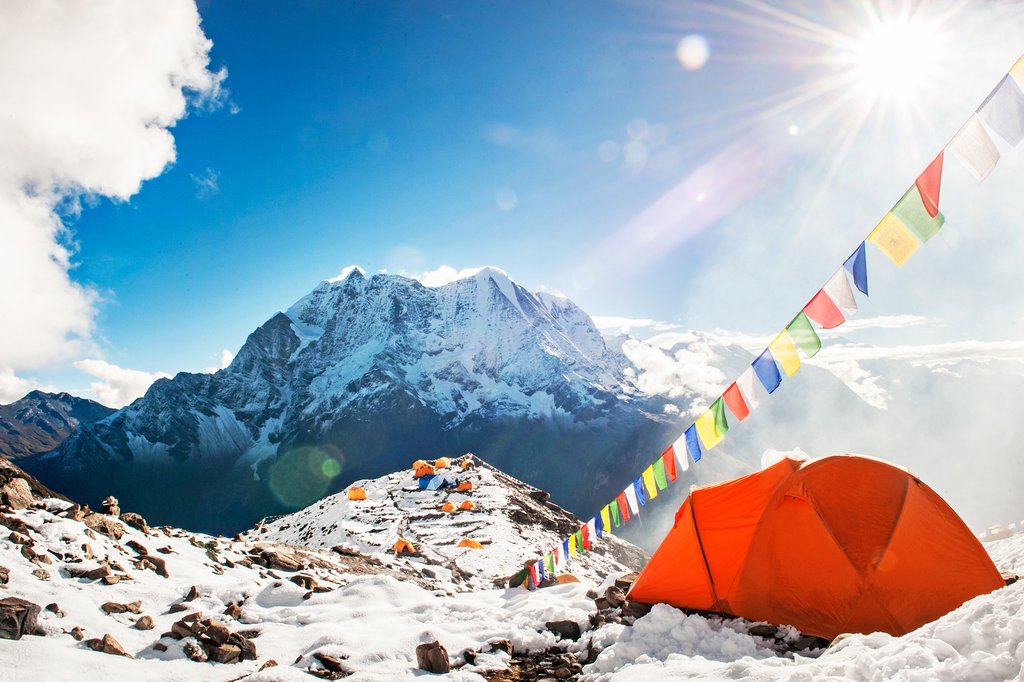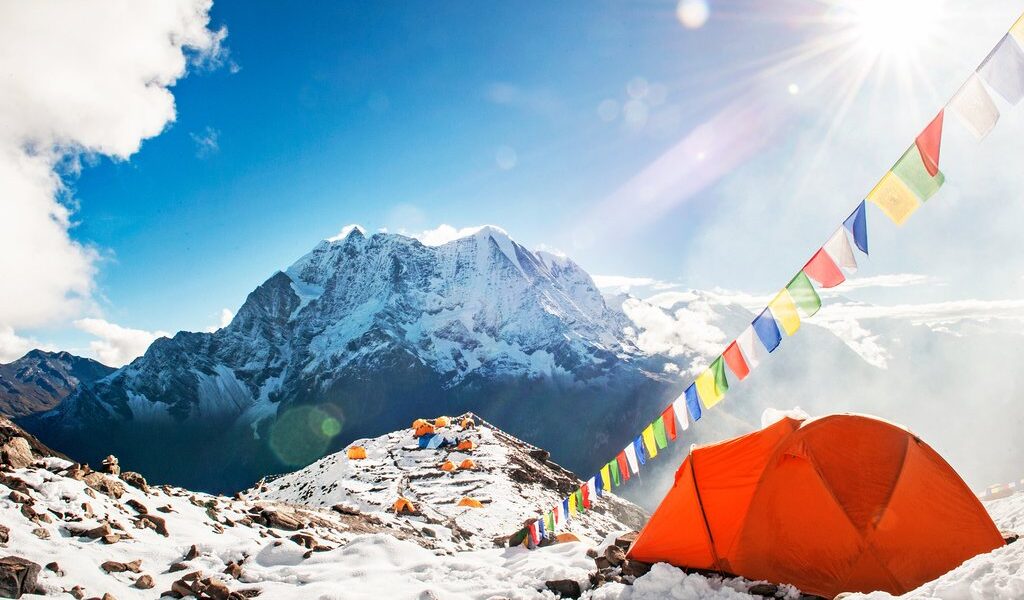
As winter sets in, the trekking trails clear of all but the bravest travelers. But, December is actually a lovely time to trek to Everest Base Camp, if you’re properly prepared for cold temperatures. Read on to find out more about trekking in the Everest region in December.
## Everest Base Camp Trek in December: A Comprehensive Guide
December in the Everest region presents a unique trekking experience. While the chilling temperatures and potential for snow require careful preparation, the reward is pristine mountain views and a serene atmosphere, free from the bustling crowds of peak season. This guide provides essential information for planning your Everest Base Camp (EBC) trek or other adventures in the region during this captivating winter month.
## Weather Conditions in December
The weather in December is characterized by cold temperatures, though not quite as frigid as those experienced in January. However, the difference is minimal, demanding adequate preparation for freezing conditions. In Namche Bazaar, the average high temperature hovers around 44°F (7°C), while the average low plunges to a brisk 21°F (-6°C). Keep in mind that Namche Bazaar sits at an altitude of 11,290 feet (3,440 meters). As you ascend to higher elevations, the temperatures will drop significantly, requiring even warmer gear.
While rainfall is minimal, it’s slightly higher than in November. The possibility of encountering snow exists anywhere along the Everest Base Camp (EBC) trail, and it’s not just confined to the higher altitudes. Despite the cold and potential for snow, December often graces trekkers with beautifully crisp and clear mountain vistas, providing unforgettable panoramic views. These clear days offer unparalleled photographic opportunities and a chance to truly appreciate the majesty of the Himalayas.
## Crowds and Costs Considerations
Following the peak trekking months of October and November, the crowds begin to dissipate in December, offering a more tranquil trekking experience. Some teahouses, the local guesthouses that provide accommodation and meals along the trails, close for the winter season as their owners temporarily relocate to Kathmandu. Despite these closures, you are unlikely to encounter difficulty securing a bed in the teahouses that remain open. It is always advisable, however, to book your accommodation in advance, especially if you are traveling with a group.
The reduced crowds can also lead to slightly lower prices for some services, though this isn’t always guaranteed. Transportation costs, such as flights to Lukla, are less likely to fluctuate drastically in December due to the stable weather patterns. However, it’s always prudent to book flights and accommodations in advance to secure the best possible rates.
## Recommended Trekking Routes for December
If you are well-prepared for cold temperatures, especially during the night, and accept the possibility of having to turn back if excessive snowfall obstructs the trail, embarking on the classic Everest Base Camp (EBC) trek remains a viable option in December. However, careful monitoring of weather conditions is crucial.
Considering the cold and potential for snowfall, it’s advisable to avoid alternative routes in the Everest region that involve crossing high mountain passes, such as the challenging Three Passes Trek. Treks that primarily stay below 13,000 feet are generally safer and more comfortable during this time. However, it remains imperative to consistently check, or have your guide check, the prevailing weather conditions as you progress along any trek in this area. Mountain weather can change rapidly, and it’s crucial to stay informed.
For a less demanding option, consider a shorter trek in the Everest region that doesn’t venture all the way to EBC. Establishing a base in Namche Bazaar presents a comfortable alternative. The town is a two-day walk from Lukla, and offers numerous rewarding day hikes in the surrounding area. While you won’t witness EBC itself from there, you can still revel in truly spectacular views of the Everest region.
Another fascinating option is to retrace the ‘Pioneers’ Route’ from Jiri to Lukla. This historic trail served as the original access route to the Everest region for early mountaineers before the construction of the airport at Lukla in the 1960s. Jiri is accessible via a day’s drive from Kathmandu. Alternatively, you can opt for a flight from Kathmandu to Phaplu and then trek through the scenic Solukhumbu region. These trails are less frequented nowadays, providing a gradual (though certainly not easy!) approach to Lukla and the wider Everest region. Expect stunning scenery and a sense of stepping back in time.
December is also an opportune time to indulge in a luxury trekking experience. The Everest region boasts several exceptional luxury lodges, rivaling the comfort of boutique accommodations in Kathmandu. These lodges provide a haven of warmth and comfort after a day of trekking in the cold.
## Essential Packing List
Adequate preparation for the cold is paramount in December, both for your safety and comfort. Although many teahouses supply blankets, they might not provide sufficient warmth for winter conditions. Investing in a high-quality winter-weight sleeping bag is highly recommended. In addition, pack a warm down jacket, prized for its lightweight and exceptional insulation. Warm clothing for evenings and nights is indispensable, as are good woolen hats, gloves, socks, and scarves. Thermal base layers are also highly advisable.
Sunscreen is also crucial, as the sun’s intensity is amplified at high altitudes, even in December. It’s best to bring your own sunscreen from home, as the variety available in Kathmandu may be limited. Lip balm with SPF protection is also essential.
Almost all other necessary winter trekking equipment can be purchased or rented from the numerous trekking shops in Kathmandu, in case you don’t own suitable gear and don’t require it back home. This can save you considerable luggage space.
## Getting To and From the Everest Region
The fastest route to the Everest region is by taking a flight from Kathmandu to Lukla. Although rainfall is less likely to cause delays and cancellations in December compared to other months, the possibility remains. Additionally, Kathmandu is prone to experiencing fog during the winter, which can potentially disrupt flights to and from Lukla, even if the weather in Lukla is clear. Therefore, building flexibility into your itinerary is highly recommended.
As an alternative, consider trekking the entire way from Jiri or Phaplu, as previously mentioned. This offers a more immersive and culturally enriching experience, allowing you to witness the diverse landscapes and communities along the way.
## December Events and Festivals
Tamu Lhosar is often celebrated in December. Due to the lunar calendar followed by Hindu and Buddhist festivals, the exact date may vary from year to year. Lhosar signifies the Tibetan Buddhist New Year, but diverse ethnic groups within Nepal celebrate distinct Lhosar festivals, some extending into February. Tamu Lhosar is celebrated by the Gurung, Magar, and Tamang communities, and is a vibrant event in Kathmandu.
And, of course, undertaking a trek in the Everest region presents an unforgettable way to celebrate New Year’s Eve. To experience Himalayan nightlife, plan to be in Namche Bazaar on December 31st. The town offers a selection of bars and restaurants. However, remember that the effects of alcohol tend to be amplified at high altitude, so moderation is advisable to avoid compromising your trek on January 1st.
## Concluding Thoughts
Trekking to Everest Base Camp in December requires diligent preparation and an awareness of the potential challenges posed by the cold weather and snow. However, the rewards are immense, including breathtaking views, a sense of accomplishment, and the opportunity to experience the Himalayas in their serene winter beauty. By following the advice outlined in this guide, you can plan a safe, comfortable, and truly unforgettable trek to Everest Base Camp in December.
B-1711

